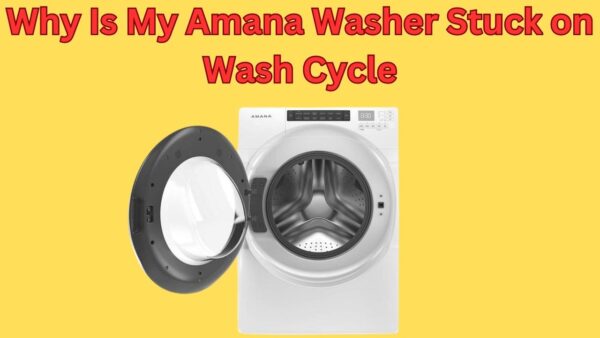Welcome! Washing machines are great time savers in our homes until they start acting up.
If you’ve noticed that your washing machine isn’t getting all your clothes wet, it can be a real head-scratcher.
But don’t worry! You’re not alone in this predicament. We’ve put together a list of 15 fixes that might just solve your problem. Let’s dive in and get those clothes properly soaked, shall we?
Washing Machine Not Getting All Clothes Wet

1. Overloading the Washing Machine
Cause
One common reason why your washing machine is not getting all clothes wet is due to overloading.
When too many clothes are stuffed into the drum, it restricts the movement of the clothes and prevents water from reaching all of them.
This can result in uneven washing, leaving some clothes completely dry.
Solution
To solve this issue, consider reducing the load size. Ensure you are not filling the drum more than three-quarters full.
This would allow enough space for clothes to move freely during the wash cycle, ensuring each garment is properly saturated.
Regularly checking your machine’s user manual for specific load size recommendations can also help in preventing overloading.
2. Low Water Level
Cause
The main cause of low water level in your washing machine is usually related to the machine’s settings.
Some washing machines come with water level selectors which allow you to choose the water level for the size of the load. If it’s set incorrectly, it may not be enough to saturate all clothes.
Solution
The solution is straightforward – adjust the water level. Check your washer’s settings and ensure that the water level is appropriate for the load size.
If this doesn’t solve the problem, your machine might have a faulty water level control switch, which would need to be checked and possibly replaced by a professional.
3. Faulty Water Inlet Valve
Cause
A faulty water inlet valve can prevent your washing machine from properly wetting all your clothes.
This valve controls the flow of water into your machine, and when it’s malfunctioning, it may not allow enough water for a complete cycle.
This can result in some clothes remaining dry even after the wash cycle.
Solution
The solution to a faulty water inlet valve is typically a replacement.
You can confirm the valve is the issue by checking for signs of wear, damage, or blockage.
If the valve is indeed faulty, it’s advisable to hire a professional or follow the manufacturer’s instructions to replace the valve.
Always ensure your machine is disconnected from power before attempting any repairs.
4. Clogged Dispenser Drawer
Cause
A clogged dispenser drawer in your washing machine can lead to the appliance not wetting all your clothes properly.
Over time, detergent and fabric softener residue can build up in the drawer, preventing the proper flow of water into the machine.
The blockage might result in an uneven distribution of water, leaving some clothes dry.
Solution
To remedy this issue, regularly clean your dispenser drawer.
Remove the drawer according to the manufacturer’s instructions, typically found in your washing machine’s user manual.
Soak it in hot water and use a soft cloth or brush to scrub away any residue. Rinse thoroughly before replacing it in the machine.
For optimal performance, consider doing this every few months, or more frequently if you notice a buildup.
5. Blocked Filter
Cause
A common cause of your washing machine not getting all your clothes wet could be a blocked filter.
Over time, small items, lint, and other debris can get trapped in the filter, preventing the machine from filling up fully and soaking all the clothes.
Solution
The solution to this problem is relatively straightforward. Locate the filter on your machine – typically found at the bottom front of the machine or at the back.
Open the cover and carefully remove the filter, making sure you have a towel or bucket ready to catch any residual water.
Rinse the filter under running water until it’s clear of any debris. Once it’s clean, reinsert the filter and run a test wash to see if this has solved the problem.
If not, it might be time to seek assistance from a professional.
6. Damaged Drum Paddles
Cause
Damaged drum paddles in your washing machine can lead to uneven distribution of water and detergent, resulting in some clothes not getting fully wet.
The drum paddles also referred to as lifters, are responsible for lifting and tumbling your laundry during a wash cycle.
When these components are worn out or broken, they can’t effectively move the clothes around, compromising the washing process.
Solution
The solution to this problem involves replacing the damaged paddles.
You can find replacement parts specific to your washing machine model from recognized spare parts retailers.
In some models, you’ll simply need to unclip the old paddle and clip the new one in place.
However, for other models, you may require professional assistance. Always refer to your washing machine’s user manual or consult a professional if you’re unsure.
7. Inappropriate Wash Cycle
Cause
Choosing an inappropriate wash cycle for the load can often result in clothes not being fully soaked.
Certain cycles are designed for specific types of laundry and may not fully saturate all items, especially if the load is mixed or overly full.
Solution
To resolve this issue, ensure you’re selecting the correct wash cycle for the type of laundry you’re washing.
Heavier items like towels and jeans require a more serious process, while delicates need a gentler one.
Avoid mixing types of laundry in one load. Always ensure the washing machine is not overloaded, allowing all items to be thoroughly wet.
8. Incorrect Detergent Usage
Cause
Overuse of detergent can lead to problems with your washing machine’s ability to thoroughly wet all of your clothes.
The excessive soap creates too many suds, which can trap clothes and prevent the water from soaking them fully.
Solution
For a practical solution, it’s important to follow the detergent manufacturer’s recommended usage instructions.
It’s typically more efficient to use less detergent than you think you need.
Additionally, consider using a detergent specifically designed for high-efficiency machines, if applicable, as these produce fewer suds and can improve the machine’s ability to wet all clothes.
9. Inadequate Water Pressure
Cause
Inadequate water pressure is a common factor that can prevent a washing machine from properly wetting all clothes.
The water supply to your washing machine is facilitated by your home’s water pressure.
If this pressure is below the optimal level, it may not be sufficient to fully saturate the laundry, leaving some clothes partially dry even after the wash cycle.
Solution
To remedy this, first, inspect and ensure that the water valves connected to your washing machine are fully open.
If the problem persists, consider consulting with a licensed plumber or washing machine technician.
They can evaluate your home’s water pressure and make necessary adjustments or repairs to ensure optimal operation of your washing machine.
10. Faulty Water Level Sensor
Cause
A faulty water level sensor in your washing machine can lead to inadequate wetting of clothes.
This sensor is responsible for determining the amount of water required for each wash cycle.
If it malfunctions, it may incorrectly read the water level, causing the machine to use less water than necessary.
Solution
Repairing or replacing the water level sensor is the best solution for this issue.
If you are comfortable with DIY repairs, you can access the sensor by following your machine’s manual, but ensure you disconnect the washer from the power supply first.
However, if you’re uncertain, it’s advisable to call a professional technician to avoid causing further damage.
11. Blocked or Kinked Inlet Hose
Cause
A blocked or kinked inlet hose effectively restricts the flow of water into your washing machine.
This can be due to accumulated sediments, mineral deposits, or in severe cases, even a kink in the hose itself.
As a result, the machine’s drum may not be able to fill sufficiently with water, preventing all clothes from being thoroughly soaked.
Solution
To resolve this issue, first, turn off the water supply and disconnect the hose from both the faucet and the washing machine. Inspect the hose for any visible kinks or obstructions.
If any are found, straighten or remove them. For internal blockages, consider soaking the hose in a solution of water and vinegar to dissolve mineral deposits.
If the hose is severely damaged or persistently kinked, it may be best to replace it with a new one.
Always ensure the hose is securely connected and the water supply is turned back on after the maintenance.
12. Malfunctioning Agitator
Cause
The agitator is the part of the washing machine that moves the clothes through the water and detergent.
When it’s not functioning correctly, the clothes may not get fully wet.
Common causes for a malfunctioning agitator include worn drive belts, faulty motor, or the agitator itself could be damaged or worn out.
Solution
To rectify a malfunctioning agitator, start by checking the drive belts. If they look worn or frayed, they likely need replacing.
If the motor is not operating at all, it could be due to a wiring issue or it might need replacing. If the agitator itself appears damaged, it may need to be replaced.
Always remember, if you’re not confident performing these checks and repairs, it’s wise to hire a professional appliance repair technician.
13. Damaged Drive Belt
Cause
A damaged drive belt may be the reason why your washing machine isn’t getting all your clothes wet.
The drive belt is a crucial component that spins the drum. If it’s worn out or broken, the drum may not spin adequately, leading to uneven water distribution.
Solution
Inspecting and replacing the drive belt may solve the problem.
Unplug the machine and remove the back panel to check the belt. If it shows signs of wear and tear or breakage, it’s time to replace it.
Ensure to purchase a belt that matches the make and model of your washing machine for optimal performance.
14. Faulty Washing Machine Timer
Cause
A faulty washing machine timer could be the reason why all your clothes are not getting wet.
The timer is responsible for regulating the duration for which each cycle in the washing process lasts.
If it’s defective, it may cause the wash cycle to end prematurely, not allowing enough water to soak all the clothes.
Solution
To rectify this issue, you’ll need to replace the faulty timer.
You can either choose to do it yourself if you’re experienced in appliance repairs, or you can hire a professional.
Before replacing, ensure to check the exact model of your washing machine to purchase the correct timer.
Following replacement, your clothes should be fully immersed in water during the wash cycle, ensuring they’re properly cleaned.
15. Worn Out Motor Coupler
Reasons
A worn-out motor coupler in your washing machine can be a reason behind the machine not getting all your clothes wet.
The motor coupler is responsible for transferring power from the motor to the transmission.
Over time, due to constant pressure and wear, it can fail or become damaged, affecting the machine’s optimal performance.
Solution
If the motor coupler is worn out, the best solution is to replace it. Before doing so, make sure to disconnect the washing machine from its power source for safety.
It’s advisable to employ a professional service technician to handle the replacement.
In general, keeping up with regular maintenance can help prevent the motor coupler from wearing out, thus ensuring that your washing machine works efficiently.
Conclusion
A washing machine not getting all clothes wet can be due to several factors.
An overloaded machine, inadequate water level, or a malfunctioning water inlet valve could be the culprits.
The balance of the load may also play a role, as clothes need to move freely to absorb water.
Regular maintenance, correct usage, and timely repair, when issues arise, can ensure your washing machine works optimally.
Most importantly, always refer to your machine’s user manual for specific guidance and troubleshooting steps.
FAQs
Why is my washing machine not getting enough water?
Your washing machine may not be getting enough water due to a blocked filter, a kinked hose, or issues with the water inlet valve.
How can I trick my washer into filling with more water?
You can trick your washer into filling with more water by resetting the load size selector to a larger setting or adjusting the water level switch.
What controls the water level in the washing machine?
The water level in a washing machine is controlled by a component known as the water level or pressure switch, which senses and regulates the amount of water in the tub.
Is a washing machine supposed to fill all the way up with water?
No, a washing machine is not supposed to fill all the way up. The water level should generally reach around halfway up the drum, providing enough water to move the clothes around without overflowing.
Bosch Washing Machine Won’t Start Just Beeps
Whirlpool Washing Machine Making Loud Banging Noise on Spin Cycle
Kenmore Washer Lid Lock Flashing
Amana Dryer Stopped Working Mid Cycle
Why Is My New Whirlpool Washer So Loud
Washing Machine High-Pitched Noise
Dryer Taking Multiple Cycles to Dry
washer won’t agitate makes noise
Whirlpool Washer Not Agitating Properly
Whirlpool Washer Won’t Agitate but Will Spin
Whirlpool Washer Locked Light Flashing
Why Do Clothes Get Stuck Under Agitator
Samsung Washing Machine No Power No Lights
GE Washer Lid Lock Light Flashing
Kenmore Dryer Keeps Shutting Off
Whirlpool Washer Stops Mid Cycle
Front Load Washer Filling With Water When Off
Why Is My Amana Washer Stuck on Wash Cycle


